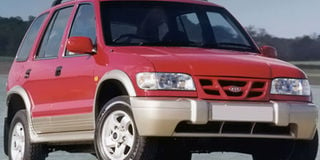Kia Sportage takes on Suzuki Vitara

Kia Sportage. NET PHOTO
The first generation Kia Sportage is a Korean four wheel drive icon, which was launched in 1995 as an outcome of a partnership between Kia, Mazda and Ford using the renowned Mazda FE 2.0 litre petrol engine. Sportage was built in South Korea, Germany and the United States with impressive off- road capability and good comfort credentials to challenge the likes of RAV4 and Suzuki Grand Vitara.
The 1999 second generation Suzuki Grand Vitara on the other hand has been around since its first generation in 1988. Assembled in Japan, Europe and United States under different names: Escudo, Vitara and Side kick, Grand Vitara draws inspiration from the legendary smaller off-roading ancestors Suzuki SJ413 of the 1960s and Samurai of the 1980s and 1990s. The Grand Vitara offered the 2.0 litre and 2.5 litre V6 petrol engines. In this edition of Head-to-head, the Suzuki Grand Vitara 2.0 litre petrol is the car to beat.
Performance
The 1999 Kia Sportage and Suzuki Grand Vitara were associated with reputable and experienced car manufacturers who developed efficient engines with impressive power delivery. The Sportage’s Mazda FE 2.0 litre petrol engine out powers Grand Vitara’s 2.0 litre petrol power plant narrowly because it has a wider cylinder bore (will burn more fuel air mixture) and an indirect fuel injection system.
Unlike Grand Vitara’s multi point petrol direct injection system (separate fuel injectors delivering high pressured fuel into each combustion chamber), Sportage’s indirect fuel injection has a small swirl chamber above the cylinder where the fuel is injected prior delivery to the combustion chamber. This system creates a higher swirl over a wide range of speeds which delivers more power and acceleration for Sportage.
Grand Vitara strikes back with better fuel economy courtesy of the efficient and less wasteful multipoint direct fuel injection. It should be noted that the performance margins between the two rivals are very narrow, so the score is even.
Handling
The Sportage and Grand Vitara are both built tough and promise to drive deep into the bush. Both vehicles have their bodies built on separate chassis platforms like other bigger off- roaders. Unlike some other rival SUVs with unitary bodies built with integrated chassis, the Sportage and Grand Vitara are articulate and can absorb off- road stress with more ease.
The Sportage and Grand Vitara have short front and rear overhangs which improve the arrival and departure angles to limit body damage when negotiating over galleys, dips or climbing up shallow water banks.
Both utility vehicles have reasonable ground clearance with independent front and rear suspension mounted on MacPherson struts and trailing links suitable for driving on uneven countryside roads. The additional all-wheel drive with a selectable high and low range four wheel drive system adds further weight to their off road credentials.
This attracts the buyers who want to visit their building sites and make family trips to the village or countryside farm. On the highway, the two rivals will have a slight roll or wallow when pushed to the extreme in sharp bends at high speeds, they are obviously not racing cars.
Styling, comfort and safety
The styling of the Sportage is much simpler than the Grand Vitara with a short front and no sharp edges or curves as if to suggest that it is a workhorse rather than ‘an indoor game’. Grand Vitara’s longer front end gives it a touch of elegance while its equally quiet and smooth curves emphasise the juxtaposing of two features; hard work and play. It is hard to fault one of the two rivals. They are both spacious. Sportage offers slightly more front legroom but Grand Vitara counter offers more shoulder room.
Kia has a bigger boot, but Grand Vitara creates more volume for cargo when all rear seats are folded. Modern comfort and safety amenities are not in short supply. Air conditioning, power mirrors and windows, radio with CD, airbags and anti-locking brakes are provided.
Reliability and resale value
The Sportage and Grand Vitara will not let you down if you maintain them well. Selection of a used unit in the bond must be carefully done after certifying the condition of the engine, gearbox, brakes, suspension and body (in case of major accident history).
Their DOHC drive trains and electronic fuel injection systems are sensitive to good quality engine oil and un adulterated unleaded fuel. Maintenance should be carried out with genuine parts. Grand Vitara’s multi point fuel injection engine is even more sensitive.
Sportage’s indirect fuel injection is easier to look after. Both products have reputable dealers (Motor centre for Kia and Cooper motors for Suzuki) to handle after sales service and parts. Independent parts and service providers exist to provide alternatives.
Generally body and suspension parts for both vehicles are costly. But that is a little price to pay for their good performance. The resale value of Grand Vitara and the Sportage is not very good because buyers are weary of the high body and suspension parts cost.
Verdict
It is a tight race with no clear winner. Sportage wins four points for better engine power, good off-road handling, good design, comfort and safety and reliability.
Grand Vitara claims four points for better fuel economy, good off-road and on road manners, as well as impressive styling, design, comfort and safety features and reliability.
Both SUVs lose a point for the dismal resale value.




